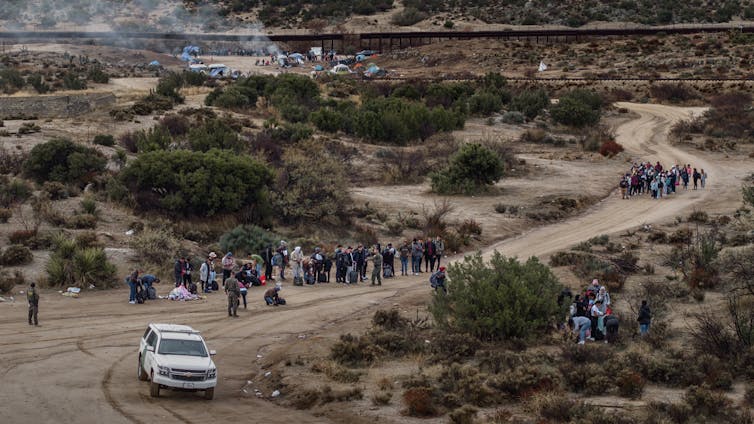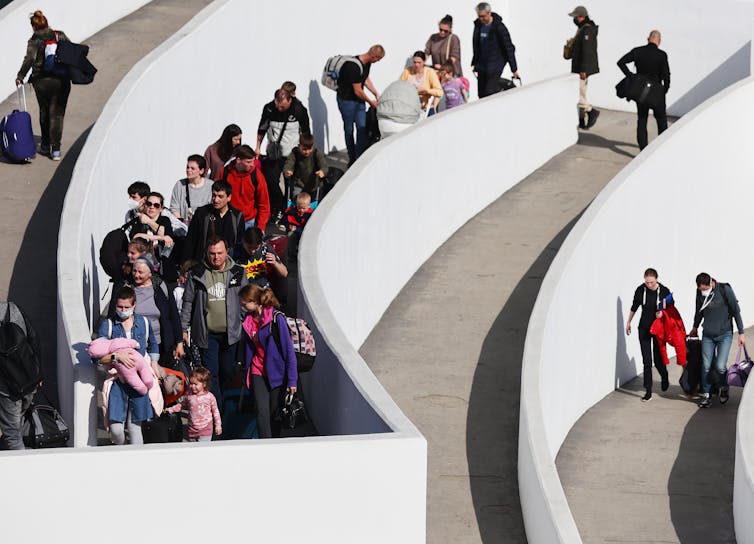There is bipartisan agreement for the need for immigration reform and stark disagreement on what that reform should be.
A rise in illegal border crossings since 2020 has applied significant pressure for changing under what conditions someone can apply for asylum. This government system is designed to provide life-saving relief for noncitizens afraid of returning to their home countries.
Undocumented migrants entering the United States have few plausible options to legally stay in the country. For many migrants fleeing their countries due to violence, war, government collapse, natural disasters or any personal threats that could harm them, the only legal pathway of immigrating to the U.S. is by receiving asylum.
Conservative Republicans in Congress are now proposing legal changes that would make it harder for most applicants to get asylum.
The Republicans’ plan is similar to both a similar rule that the Department of Homeland Security adopted in 2019 and a policy that President Joe Biden is trying to push through.
I am an immigration professor and teach asylum law. I believe it’s important to understand what sets Republicans’ proposed law apart from previous iterations.
The president cannot change the law, but Congress can. If these lawmakers succeed in changing federal asylum law, the law would override the court decisions striking down previous versions. Because Congress has broad power over immigration, the new laws would likely be upheld if challenged in court.
Still, currently, most people who seek asylum do not receive permission to stay in the country, and they are deported.

Understanding asylum
Currently, any noncitizen, including someone who already lives in the U.S. or who entered the country without a visa – can apply for asylum. This is true regardless of the person’s legal immigration status.
A person can ask the U.S. government for asylum only once they are in the country or at the border – and they must ask for asylum within a year of arriving in the U.S.
Applying for asylum is a complicated process that could take several years. Undocumented migrants often apply for asylum while they are detained in an immigration detention center.
Overall, asylum applicants will need to prove that they face severe harm in their home country from their government or someone their government cannot control, like an armed militia group. This potential severe harm must trace back to their race, religion, political opinion, nationality or some characteristic they cannot, or should not have to, change.
Asylum seekers first make their case to a U.S. government asylum officer, who judges the veracity of their claim in an interview.
If migrants pass this first interview, the migrant is allowed to seek asylum before an immigration judge.
At this stage, asylum seekers will need to show extensive evidence of events and other conditions that place them in severe danger if they are deported. Getting this proof is very difficult for asylum seekers, who typically require the help of an attorney to complete this application process.
Even if an applicant meets all of the requirements to get asylum, a judge still has the discretion to decide whether or not this person should receive it.
Judges then give some migrants asylum, allowing them to apply for U.S. green cards, which are the documents that give someone legal permission to remain in the U.S. They can then lawfully work, receive certain government benefits and eventually apply for citizenship.
A backlog
As a result of the rising number of undocumented migrants crossing into the U.S. – increasingly from places with widespread government instability and violence, like Venezuela and Honduras – asylum requests are also on the rise.
Asylum cases in immigration court more than tripled between 2021 and 2022, rising from 63,074 to 238,841. And the asylum case numbers continue to grow.
This rise in asylum applications is then coupled with a growing backlog of asylum cases in immigration court.
There are 3 million cases still waiting to go before a judge in immigration courts – 1 million of these are asylum cases. In comparison, the average number of backlogged asylum cases from 2012 through 2016 consistently remained below 200,000.
Consequently, people seeking asylum typically now wait an average of four years before they have an asylum hearing in court – and, in many cases, may wait longer for a decision that they have appealed.
An asylum seeker may, in some cases, apply for a work permit if they must wait more than six months for a decision.
Republican plan
Conservative House Republicans are now threatening a government shutdown that could happen as early as Jan. 19, 2024. They also have blocked more foreign aid to Ukraine and Israel, and are using their power over this aid as leverage for changing asylum laws.
Biden, meanwhile, wants Congress to approve nearly US$14 billion to pay for more border security agents, as well as asylum officers and immigration judges.
Republicans have rejected Biden’s proposal and instead want new laws that would deny asylum to any migrant who passed through a third country while traveling to the U.S., or who did not enter the U.S. at an official port of entry along a border.
These changes target the fact that most migrants who cross into the U.S. without documentation – and apply for asylum – come from countries other than Mexico. But these people, coming from countries like Venezuela, Haiti and Cuba, first pass through Mexico on their way to the U.S. Approximately 71% of the over 2.4 million people who were apprehended at the southern border in 2023 traveled through Mexico, but were not Mexican citizens.
If this proposed law is passed, these migrants would no longer have a court consider their asylum applications.
Instead, they would not be allowed to apply for asylum. They would be immediately deported back to their own countries.
Democrats have opposed the changes when they were proposed as part of a bill in May 2023, but some Democrats are more open to asylum restrictions and may compromise to reach a deal.

Not the first go-around
The proposed change that would deny asylum to those who have traveled through a third country is identical to a Department of Homeland Security rule that the agency adopted under former president Donald Trump’s administration in 2019.
Biden has proposed a similar policy, with exceptions for a migrant who obtained special permission to enter the U.S., or who was denied asylum in another country. The Ninth Circuit Court of Appeals struck down Trump’s rule in 2020 because it violated current asylum law that permits anyone to seek asylum, regardless of how they enter the U.S.
The president cannot change the law.
A federal district court struck down Biden’s policy in July 2023 on the same basis. Biden has appealed that decision.
Republicans are proposing other laws to make it harder to receive asylum. One change would require asylum seekers to present a large amount of evidence proving their fear of persecution during their first interview with a government asylum officer – not later, when they go before a judge. The law would also end programs that allow migrants to stay with sponsors in the U.S. while seeking asylum.
In summary, the proposed changes would make it almost impossible for a migrant entering through the U.S.-Mexico border to get asylum, even if that migrant has a legitimate fear of returning to his or her home country.

